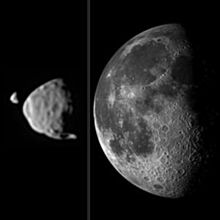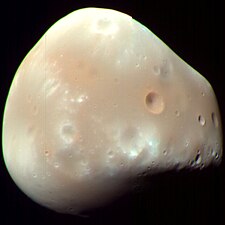Deimos
(Deimos: Moon Of Mars,discovery,exploration,structure)
Deimos (systematic designation: Mars II) is the smaller and outer of the two natural satellites of the planet Mars, the other being Phobos. Deimos has a mean radius of 6.2 km (3.9 mi) and takes 30.3 hours to orbit Mars. The name Deimos is pronounced /ˈdaɪmɒs/ DY-mos, /'deɪmɒs/, or sometimes /ˈdiːməs/ DEE-məs or like the Greek Δεῖμος.[citation needed] In Greek mythology, Deimos was the twin brother of Phobos and personified terror.
Discovery
 Deimos was discovered by Asaph Hall, III at the United States Naval Observatory in Washington, D.C on 12 August 1877, at about 07:48 UTC (given in contemporary sources as "11 August 14:40" Washington Mean Time, using an astronomical convention of beginning a day at noon, so 12 hours must be added to get the actual local mean time). Hall also discovered Phobos on 18 August 1877, at about 09:14 GMT, after deliberately searching for Martian moons.
Deimos was discovered by Asaph Hall, III at the United States Naval Observatory in Washington, D.C on 12 August 1877, at about 07:48 UTC (given in contemporary sources as "11 August 14:40" Washington Mean Time, using an astronomical convention of beginning a day at noon, so 12 hours must be added to get the actual local mean time). Hall also discovered Phobos on 18 August 1877, at about 09:14 GMT, after deliberately searching for Martian moons.It is named after Deimos, a figure representing dread in Greek mythology. The names, at first spelled Phobus and Deimus, were suggested by Henry Madan (1838–1901), Science Master of Eton, from Book XV of the Iliad, where Ares (the Roman god Mars) summons Dread (Deimos) and Fear (Phobos).
Orbital characteristics
 Deimos's orbit is nearly circular and is close to Mars's equatorial plane. Deimos is possibly an asteroid that was perturbed by Jupiter into an orbit that allowed it to be captured by Mars, though this hypothesis is still controversial and disputed. Both Deimos and Phobos have very circular orbits which lie almost exactly in Mars's equatorial plane, and hence a capture origin requires a mechanism for circularizing the initially highly eccentric orbit, and adjusting its inclination into the equatorial plane, most likely by a combination of atmospheric drag and tidal forces, although it is not clear that sufficient time was available for this to have occurred for Deimos.
Deimos's orbit is nearly circular and is close to Mars's equatorial plane. Deimos is possibly an asteroid that was perturbed by Jupiter into an orbit that allowed it to be captured by Mars, though this hypothesis is still controversial and disputed. Both Deimos and Phobos have very circular orbits which lie almost exactly in Mars's equatorial plane, and hence a capture origin requires a mechanism for circularizing the initially highly eccentric orbit, and adjusting its inclination into the equatorial plane, most likely by a combination of atmospheric drag and tidal forces, although it is not clear that sufficient time was available for this to have occurred for Deimos.As seen from Mars, Deimos would have an angular diameter of no more than 2.5 minutes (sixty minutes make one degree), one twelfth of the width of the Moon as seen from Earth, and would therefore appear almost star-like to the naked eye. At its brightest ("full moon") it would be about as bright as Venus is from Earth; at the first- or third-quarter phase it would be about as bright as Vega. With a small telescope, a Martian observer could see Deimos's phases, which take 1.2648 days (Deimos's synodic period) to run their course.
Unlike Phobos, which orbits so fast that it actually rises in the west and sets in the east, Deimos rises in the east and sets in the west. However, the Sun-synodic orbital period of Deimos of about 30.4 hours exceeds the Martian solar day ("sol") of about 24.7 hours by such a small amount that 2.7 days elapse between its rising and setting for an equatorial observer.
Because Deimos's orbit is relatively close to Mars and has only a very small inclination to Mars's equator, it cannot be seen from Martian latitudes greater than 82.7°.
Deimos's orbit is slowly getting larger, because it is far enough away from Mars and because of tidal acceleration. It is expected to eventually escape Mars's gravity.
Exploration
The relative sizes of Deimos and Phobos as seen from Mars, compared to the relative size of the Moon as seen from Earth
Overall, its exploration history is similar to those of Mars and of Phobos. Deimos has been photographed in close-up by several spacecraft whose primary mission has been to photograph Mars. No landings on Deimos have been made.
 The Soviet Phobos program sent two probes to Phobos. In case Phobos 1 succeeded, Phobos 2 could have been sent to Deimos. Both probes launched successfully in July 1988. The first was lost en route to Mars, whereas the second returned some data and images but failed shortly before beginning its detailed examination of Phobos's surface, including a lander.
The Soviet Phobos program sent two probes to Phobos. In case Phobos 1 succeeded, Phobos 2 could have been sent to Deimos. Both probes launched successfully in July 1988. The first was lost en route to Mars, whereas the second returned some data and images but failed shortly before beginning its detailed examination of Phobos's surface, including a lander.In 1997 and 1998, the proposed Aladdin mission was selected as a finalist in the NASA Discovery Program. The plan was to visit both Phobos and Deimos, and launch projectiles at the satellites. The probe would collect the ejecta as it performed a slow flyby (~1 km/s). These samples would be returned to Earth for study three years later. The principal investigator was Carle M. Pieters of Brown University. The total mission cost, including launch vehicle and operations was $247.7 million. Ultimately, the mission chosen to fly was MESSENGER, a probe to the planet Mercury.
In 2008, NASA Glenn Research Center began studying a Phobos and Deimos sample-return mission that would use solar electric propulsion. The study gave rise to the "Hall" mission concept, a New Frontiers-class mission currently under further study.
Also, the sample-return mission called Gulliver has been conceptualized and dedicated to Deimos, in which 1 kilogram (2.2 pounds) of material from Deimos would be returned to Earth.
Another concept of sample-return mission from Phobos and Deimos is OSIRIS-REx 2, which would use heritage from the first OSIRIS-REx.
In March 2014, a Discovery class mission was proposed to place an orbiter on Mars orbit by 2021 and study Phobos and Deimos. It is called Phobos And Deimos & Mars Environment (PADME).



No comments:
Post a Comment